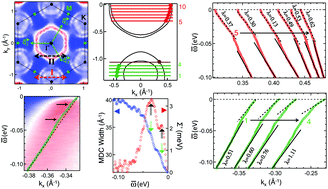当前位置:
X-MOL 学术
›
J. Mater. Chem. C
›
论文详情
Our official English website, www.x-mol.net, welcomes your
feedback! (Note: you will need to create a separate account there.)
Spectroscopic signature of moment-dependent electron–phonon coupling in 2H-TaS2
Journal of Materials Chemistry C ( IF 5.7 ) Pub Date : 2017-09-07 00:00:00 , DOI: 10.1039/c7tc02641b Kapila Wijayaratne 1, 2, 3, 4 , Junjing Zhao 1, 2, 3, 4 , Christos Malliakas 4, 5, 6, 7 , Duck Young Chung 4, 8, 9, 10 , Mercouri G. Kanatzidis 4, 5, 6, 7, 8 , Utpal Chatterjee 1, 2, 3, 4
Journal of Materials Chemistry C ( IF 5.7 ) Pub Date : 2017-09-07 00:00:00 , DOI: 10.1039/c7tc02641b Kapila Wijayaratne 1, 2, 3, 4 , Junjing Zhao 1, 2, 3, 4 , Christos Malliakas 4, 5, 6, 7 , Duck Young Chung 4, 8, 9, 10 , Mercouri G. Kanatzidis 4, 5, 6, 7, 8 , Utpal Chatterjee 1, 2, 3, 4
Affiliation

|
Charge density wave (CDW) order is ubiquitous among low-dimensional electronic systems, as realized in layered materials such as various 1T and 2H polytypes of transition metal dichalcogenides (TMDs). In particular, 2H-TaS2, a prominent member of the vast family of TMDs, hosts a canonical CDW phase transition whose mechanism remains controversial even after decades of research. Using state-of-the-art angle resolved photoemission spectroscopy (ARPES) measurements, we report, for the first time, pronounced many-body renormalizations in 2H-TaS2. These renormalizations are manifested by the presence of multiple slope changes, known as “kinks”, in the electronic dispersions. The temperature independence of the kink energies and their close correspondence with the phonon frequencies of the system evidence that these renormalizations are caused by electron–phonon interactions. In addition, the electron–phonon coupling parameter is momentum-dependent, and the CDW vector is not compatible with any of the Fermi surface nesting vectors. Collectively, these observations establish that the origin of the CDW transition in 2H-TaS2 is not the same as that of the Peierls ordering transition, rather this transition is triggered by strong electron–phonon coupling including its momentum anisotropy. The commonality between the ARPES data on 2H-TaS2 and those on 2H-TaSe2 and 2H-NbSe2 rationalize the above interpretation of the CDW transition being generic to incommensurate CDW orders in 2H polytypes of TMDs.
中文翻译:

2 H -TaS 2中依赖于矩的电子-声子耦合的光谱特征
电荷密度波(CDW)顺序在低维电子系统中是普遍存在的,这是在分层材料中实现的,例如各种1 T和2 H多型过渡金属二卤化物(TMD)。特别地,2 H -TaS 2是广大TMD家族的重要成员,它具有规范的CDW相变,即使经过数十年的研究,其机理仍然存在争议。使用最新的角度分辨光发射光谱(ARPES)测量,我们首次报告了在2 H -TaS 2中明显的多体重新归一化。这些重新归一化通过电子色散中多个斜率变化(称为“扭结”)的存在来证明。纽结能量的温度独立性及其与系统声子频率的紧密对应关系证明了这些重新归一化是由电子-声子相互作用引起的。另外,电子-声子耦合参数与动量有关,并且CDW向量与任何费米表面嵌套向量都不兼容。总而言之,这些观察结果确定了CDW跃迁在2 H -TaS 2中的起源。与Peierls有序跃迁不同,而是由强烈的电子-声子耦合(包括动量各向异性)触发的。上2 ARPES数据之间的共性ħ μ-TAS 2和那些在2 ħ -TaSe 2和2 ħ -NbSe 2理顺CDW过渡是通用于不适应CDW订单2个的上述解释ħ TMD所多型体。
更新日期:2017-09-19
中文翻译:

2 H -TaS 2中依赖于矩的电子-声子耦合的光谱特征
电荷密度波(CDW)顺序在低维电子系统中是普遍存在的,这是在分层材料中实现的,例如各种1 T和2 H多型过渡金属二卤化物(TMD)。特别地,2 H -TaS 2是广大TMD家族的重要成员,它具有规范的CDW相变,即使经过数十年的研究,其机理仍然存在争议。使用最新的角度分辨光发射光谱(ARPES)测量,我们首次报告了在2 H -TaS 2中明显的多体重新归一化。这些重新归一化通过电子色散中多个斜率变化(称为“扭结”)的存在来证明。纽结能量的温度独立性及其与系统声子频率的紧密对应关系证明了这些重新归一化是由电子-声子相互作用引起的。另外,电子-声子耦合参数与动量有关,并且CDW向量与任何费米表面嵌套向量都不兼容。总而言之,这些观察结果确定了CDW跃迁在2 H -TaS 2中的起源。与Peierls有序跃迁不同,而是由强烈的电子-声子耦合(包括动量各向异性)触发的。上2 ARPES数据之间的共性ħ μ-TAS 2和那些在2 ħ -TaSe 2和2 ħ -NbSe 2理顺CDW过渡是通用于不适应CDW订单2个的上述解释ħ TMD所多型体。









































 京公网安备 11010802027423号
京公网安备 11010802027423号